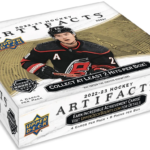Hockey Hobby Boxes represent a vibrant and often lucrative market for collectors and investors. This segment delves into the current state of the hockey hobby box industry, exploring everything from market size and trends to the intricacies of card valuation and investment strategies. We’ll examine the various types of boxes available, their price points, and the potential returns they offer, providing insights for both seasoned collectors and newcomers alike.
Understanding the nuances of this market requires careful consideration of factors ranging from rookie card potential to the crucial role of card grading.
The market is dynamic, influenced by player performance, historical significance, and the ever-evolving tastes of collectors. This analysis will dissect the key players, price fluctuations, and the communities that drive this passionate hobby, offering a comprehensive overview of the Hockey Hobby Boxes landscape.
The Value of Cards within Hockey Hobby Boxes

The value of hockey cards found within hobby boxes is a complex interplay of several factors, fluctuating wildly based on market demand and the card’s inherent characteristics. Understanding these factors is crucial for both collectors seeking investment opportunities and those simply enjoying the thrill of the rip. The potential for significant returns, or even losses, necessitates a discerning eye.
Factors Determining Card Value
Several key factors influence the value of individual cards. Rarity, player performance, card condition, and the overall market climate all contribute to a card’s worth. A highly sought-after rookie card of a player who goes on to have a Hall of Fame career, for instance, will naturally command a higher price than a common card of a lesser-known player.
Similarly, the condition of the card—free from creases, scratches, or other imperfections—significantly impacts its value. A pristine card will fetch far more than a damaged one. Finally, broader economic conditions and trends within the sports card market also play a role.
Rookie Cards and Appreciation Potential
Rookie cards, representing a player’s first officially licensed trading card, are often considered the most valuable cards in a set. The potential for appreciation is substantial, particularly for players who go on to achieve significant success in the NHL. For example, a Connor McDavid rookie card from his 2015-16 Upper Deck Young Guns series has seen remarkable price appreciation since its release.
Similarly, early cards of Sidney Crosby or Auston Matthews have demonstrated strong growth, showcasing the investment potential of these key rookie cards. However, it’s crucial to remember that not all rookie cards appreciate in value; the player’s career trajectory is a major determinant.
The Significance of Card Condition (Grading)
The condition of a hockey card is paramount in determining its value. Professional grading services, such as PSA (Professional Sports Authenticator) and Beckett Grading Services (BGS), assess cards based on a numerical scale, reflecting the card’s overall condition. A higher grade, indicating a more pristine card, translates to a significantly higher value. For example, a PSA 10 (gem mint) graded card will be worth substantially more than a PSA 8 (near mint-mint) card, even if they are of the same player and year.
This grading process adds a layer of objectivity and transparency to the market, allowing buyers and sellers to confidently assess a card’s value.
Identifying Rare and Valuable Cards, Hockey Hobby Boxes
Identifying rare and valuable cards requires a keen eye and a solid understanding of hockey card history and market trends. Key indicators include the card’s rarity (indicated by print run size or designated rarity levels within the set), the player’s prominence, and the condition of the card. Looking for short-printed parallels or variations within a set can be particularly fruitful.
Researching online databases and price guides, such as those offered by Beckett or eBay, can help determine a card’s potential value. Additionally, paying attention to specific card features, such as error cards (printing mistakes), can uncover hidden gems within a hobby box. However, it’s essential to be wary of counterfeits, so verifying authenticity through reputable sources is vital.
Investing in hockey hobby boxes presents a unique blend of risk and reward. While the potential for significant returns exists, thorough market research and a keen understanding of card valuation are essential. Building a successful collection requires patience, diligence, and engagement with the vibrant community of collectors. By understanding the factors influencing card value, leveraging online resources, and employing sound investment strategies, individuals can navigate this dynamic market and potentially reap substantial rewards from their passion for the game.


